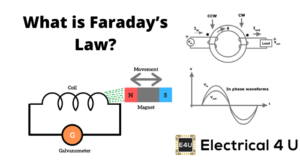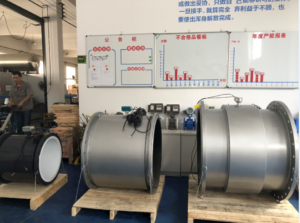Heavy industry and manufacturing often have the need to measure the flow of materials through pipes and processes. When the material is a free-flowing liquid, there are many means to do this. However, when the plant is pumping cement, pulp, or slurry, this measurement can become problematic. Many flowmeters depend on a sensor positioned within the inside diameter of the pipe. When dealing with solids suspended in a liquid, this configuration just does not work.
The Solution: electromagnetic flowmeters. These flowmeters are capable of measuring the exact flow of slurry and semi-solid material suspended in liquid with amazing accuracy.

- How do electromagnetic flowmeters work?
Without going into a lot of boring physics, electromagnetic flowmeters—or “mag meters” as they are known in the industry—rely on Faraday’s Law of Electromagnetic Flow Induction. In short, as fluid, cement, or slurry flow through a pipe in which there is a magnetic field, the conductive particles change the voltage in the field. The mag meter detects these changes and uses a microprocessor to compute the flow—with amazing accuracy. The important thing is not so much understanding how they work, but trusting that they do work.
With a base in solid physics, electromagnetic flowmeters are industry-proven and are used in processes around the globe as a trusted device in the measurement of flow. This is particularly the case when hard-to-measure materials require precise measurement.

- What industries use electromagnetic flowmeters?
Any industry that requires accurate measurement of fluid flowing through a pipe can take advantage of mag meters. Industries, where they are the flowmeter of choice, include, but are not limited to, the following:
- Cement plants
- Paper mills
- Textile plants
- Oil and gas industry
- Chemical plants
- Food production facilities
- Waste treatment plants
- And many others
The beauty of electromagnetic flowmeters is they are adaptable to almost any situation where it is critical to accurately determine the correct flow through a pipe.
- What does an electromagnetic flowmeter consist of?
The simplicity of design is what makes electromagnetic flowmeters the flow-detection device of choice. Sensors on the pipe measure the flow and send the signal to a converter which relays the flow rate to operators. It really is that simple. Mag meters are extremely reliable and work consistently without the need for constant recalibration.
- What are the features and benefits of an electromagnetic flowmeter?
- They can be installed on very large pipes—up to 800mm.
- The flow measurement is not affected by changes in:
- Fluid density
- Viscosity
- Temperature
- Pressure
- Conductivity
- There is no obstruction component in the pipe that can cause pressure/flow loss.
- Electromagnetic flowmeters are low maintenance.
- They are designed for superior corrosion and wear resistance.
- They can utilize a wide range of power supplies and have excellent Electromagnetic Interference (EMI) resistance.
- Mag meters use super-fast microprocessors that can self-test and self-diagnose.
So, when your process demands a high degree of precision and your product is not an ordinary liquid, consider an electromagnetic flowmeter to solve your flow measurement problem.
For more information on electromagnetic flowmeters, click here.

